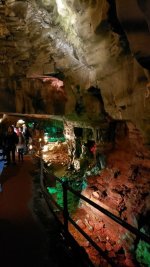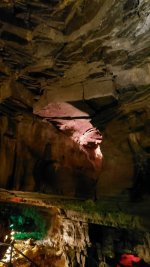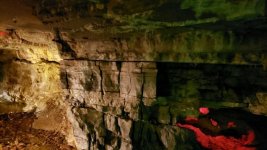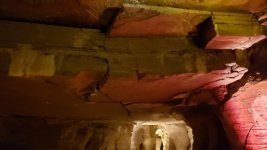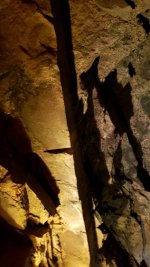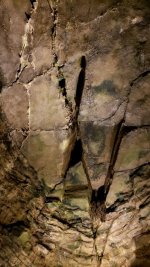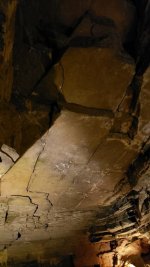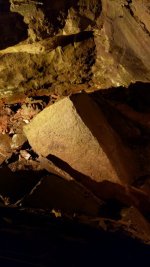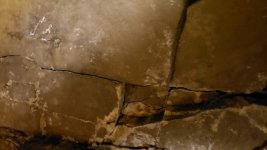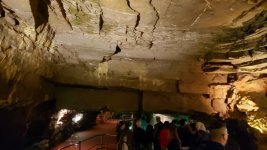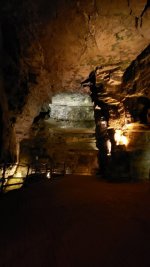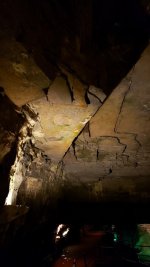Allow me to introduce you to Howe Caverns. The Howe Caverns is a cave in Howes Cave, Schoharie County, New York. Howe Caverns is a popular tourist attraction. Howe Caverns is the second most visited natural attraction in New York State, after Niagara Falls.

R: Wikipedia is ever the minimizer with the uber descriptive 'cave' moniker. In fact Howe caverns is an extensive series of caverns stretching close to 2 miles over 100 feet under ground. A stream with clear, pure water runs the length of it, sometimes becoming so deep that you need a boat to traverse it. Additionally, the roof of this tunnel (let's call a spade a spade) gets as high as 60 feet in places, and has blocked rock pieces, sometimes dripping with mortar.
There is evidence of large brickwork, and hard corners, and, one of the most fascinating aspects to me are its temple like features- votive-like indentations, and a worn down bust they call "the witch".


R: There are other similar caverns in the area, one called 'Secret Caverns' and another called McFlail's cave. In Secret Caverns, there is a huge, worn out sculpture of a monster or alligator. (See below).

Howe had his daughter married on an altar like stone space.

R: The thing that REALLY caught my attention, though, was the fact that
Here are a couple maps, to show the extensiveness of these caverns.


Back to wiki: Geologists believe the formation of the cave, which lies 156 feet (48 m) below ground, began several million years ago. Composed mainly of two types of limestone (Coeymans and Manlius) from different periods in the Earth's early history, deposited hundreds of millions of years ago when the Atlantic Oceanstretched far inland, the cave contains a lake, called the Lake of Venus, as well as many speleothems...the cave is at a constant temperature of 52 degrees Fahrenheit, irrespective of the outside weather.
Howe Caverns website states:
Howe settled in the valley east of Cobleskill. The location of the cave entrance had been lost to history, but there was talk of a mysterious “Blowing Rock” – a strange rocky ledge from which a cool breeze of air emanated on even the hottest days.
Howe and his family farm were located adjacent to the caverns’ hidden entrance...There is no doubt Howe was fascinated by stories of the strange local phenomenon “Blowing Rock.” Reports of the day placed its location just north of the “Kobles Kill” and ten miles west of the Schoharie River – on or near his property.
In 1843, Howe built his first cave house hotel at the natural entrance site. When it burned in 1847, it was rebuilt with the new hotel directly above the caverns’ entrance. Visitors entered the cave through a stairway in the basement. Cool air from the cave circulated through the hotel. Lester Howe had invented the first form of air conditioning, offering guests of the Cave House a respite during the warm summer months.
Through the years, Howe’s Cave grew in popularity especially with the advent of the Albany and Susquehanna Railroad in 1865. Visitors could arrive and depart from the station established at Howe’s Cave, an easy walk to the Cave House Hotel. The number of guests to the cave increased steadily. Howe’s Cave became a leading natural New York attraction, second only to Niagara Falls — a status it maintains today.
But, times changed. In January 1872, the second Cave House burned. A third Cave House (current) was built. It was at this time Lester Howe had transferred his property to the Howe’s Cave Association as he had over-extended himself in property expansion. The Howe’s Cave Association eventually added on an imposing structure called the Pavilion Hotel.
R: There are reports that JP Morgan visited the caverns, and described his time down there-still looking for this, as I find it very telling. There must have been something down there, of value and use. Check out excerpt from old book further down.
Howe Website again: From 1890 until the turn of the century, as visitors steadily decreased, a small community of management, quarry workers and their families sprang up in the hamlet now known as Howes Cave. In 1898, The Howes Cave Association, which had purchased the site from Lester Howe, reorganized as the Helderberg Cement Company. The firm discontinued tours, and cement manufacturing went into high speed. In place of the visitors coming to see the caverns, a constant succession of owners quarried limestone from the hillside for cement. While the Cave House Hotel had been rebuilt and had a heyday from 1871-1890, the wooden portion called the Pavilion Hotel, burned in 1909. The remaining Cave House became a boarding house and later office space for the cement company.
R: it is worth noting that there are small antiquetech antennae covering the roof of remaining structure, but my focus is the caverns.
While the precise year is unknown, sometime between 1910-1925, the first charges in the limestone walls of the quarry face blasted into Howe’s Cave. Over the years, about 875 ft. of the “old” cave have been destroyed. Today, visitors see less than half of the original underground passage.
From The Remarkable Howe Caverns Story by Dana Cudmore, The Overlook Press, Woodstock, NY, Copyright 1990.
R: It appears that many newer articles are eager to paint natives of the area of being creeped out by the caverns, and possessing no tools being down there, as per this quote from Howe Caverns.
"Before white settlers arrived, the Iroquois natives knew it as Otsgaragee, "Cave of Great Galleries". They associated caves with the underworld and death, and no American Indianartifacts have been discovered in Howe or Secret Caverns"
R: This article from 1866 does, however, make mention of tools being found. I've copied and pasted the items that really stood out, bolding is mine.
The following reprint of a fascinating newspaper article from 1886. The Sun, New York, N.Y., 12 Dec. 1886, page 6. THE CAVES OF SCHOHARIE.
A county full of curious caverns in central New York. The Wonders of Ball’s Cavern, which Only a Dozen Persons Have Ever Explored - The Perils of McFlail’s Cave - Bottomless Pits.
"The first persons who ever undertook to explore this dangerous cavern were John Gebhardt, Wm. Hubbard, and John Branch. Finding that thorough exploration could not be made without boats, Gebhardt had two made for the purpose, and lowered them into the depths. Several prominent citizens of the county accompanied him on this trip to the unknown region. They found the walls covered with a material resembling whitewash.... The geological specimens they brought back with them are among the rarest known to science. Probably not more than a dozen persons have visited this curious cavern since the pioneer exploration. [See an account of the 1831 exploration of Balls (now Gage) Cave in the December 2003 Caver.]
The towns of this county especially noted for the possession of these remarkable caverns are Carlisle, Schoharie, and Cobleskill.
Not far from Carlisle village, south of it, is a curious cave known as the "Rock House." This is easy of access. It is about forty feet square. A turbulent stream flows through it and disappears in a number of dark openings which have never been explored. The roof of this cavern is apparently a stratum of slate, and light is let into the cave through several large fissures in it. Many stone implements, rude earthen jars, and warlike weapons were found in the Rock House by its early explorers. When the Indians still held possession of this region the cave was a favorite retreat to them, and long after the Revolution human skeletons were found in its depths...McFlail’s Cave is a series of narrow passages opening into irregularly-shaped chambers, and coursed by rapid streams, with here and there a small lake, fathomless pits, and steep, ragged descents. Not a few credulous natives declare that the lake is haunted, and those who have ventured into its depths say that the weird responses a shout awakens among its damp aisles and openings might easily be taken for the voices of unearthly dwellers....There are many caverns in the neighborhood of Carlisle, to enter which it is necessary for the visitor to let himself down by ropes through perpendicular openings from 20 to 100 feet deep. Some of these approaches to subterranean depths have straight walls from top to bottom, while others are funnel shaped, and others still formed like an immense hour-glass contracted in the centre and with funnel-shaped openings on the surface and in the cave...
Another strange feature of these underground recesses are the bottomless pits that abound. These are openings in the floor, some of them ten feet across, and as round as though they had been bored in the rock with a huge drill. Many of them are fathomless. Some are filled up with water, others are dry. Corridors, narrow and low, run in all directions, and in their labyrinth lies great danger to the explorer, and an insuperable obstacle to thorough investigation of the mysteries of these caves...One family living in close proximity to a cave of this kind in 1869 was forced to fly to the second story of the house to escape the rapid rise of water from the earth, and were removed from their dangerous situation in boats
R: was this in reference to the deluge?
Here is a picture of the caverns location on the map of NY.

R: And here is a picture of the state flag. Notice the location of this pyramidal mountain with rising sun emitting from it. That off centered setup cannot be an accident, can it?

R: Imho, the above photos and quotes clearly demonstrate that the caverns are some type of manmade structure. Imo the Iroquois legend of the stone giants, is the key to what kind of men these builders were. I'll just leave a quick description and a few pics, and elaborate further in a future post.
"The Iroquois believed that in early days there existed a malignant race of giants whose bodies were fashioned out of stone. It is difficult to say how the idea of such beings arose, but it is possible that the generally distributed conception of a gigantic race springing from Mother Earth was in this instance fused with another belief that stones and rocks composed the earth's bony framework."
R: Here are a couple drawings of these giants.
R: Wikipedia is ever the minimizer with the uber descriptive 'cave' moniker. In fact Howe caverns is an extensive series of caverns stretching close to 2 miles over 100 feet under ground. A stream with clear, pure water runs the length of it, sometimes becoming so deep that you need a boat to traverse it. Additionally, the roof of this tunnel (let's call a spade a spade) gets as high as 60 feet in places, and has blocked rock pieces, sometimes dripping with mortar.
There is evidence of large brickwork, and hard corners, and, one of the most fascinating aspects to me are its temple like features- votive-like indentations, and a worn down bust they call "the witch".
R: There are other similar caverns in the area, one called 'Secret Caverns' and another called McFlail's cave. In Secret Caverns, there is a huge, worn out sculpture of a monster or alligator. (See below).
Howe had his daughter married on an altar like stone space.
R: The thing that REALLY caught my attention, though, was the fact that
- the caverns temperature remains at a constant temperature of 52 degrees Fahrenheit, irrespective of the outside weather.
Here are a couple maps, to show the extensiveness of these caverns.
Back to wiki: Geologists believe the formation of the cave, which lies 156 feet (48 m) below ground, began several million years ago. Composed mainly of two types of limestone (Coeymans and Manlius) from different periods in the Earth's early history, deposited hundreds of millions of years ago when the Atlantic Oceanstretched far inland, the cave contains a lake, called the Lake of Venus, as well as many speleothems...the cave is at a constant temperature of 52 degrees Fahrenheit, irrespective of the outside weather.
Howe Caverns website states:
- Howe Caverns, which was discovered 20 years before the outbreak of the Civil War, has a history that follows America’s transformation from a farm-based economy to an industrial nation.
- The first white man to enter the cave did so in the early 1770s. Perhaps Johnathan Schmul, a peddler, had been calling on families in the mill town of Kobel’s Kill (today, Cobleskill) when he sought refuge from a Native American attack by hiding at the entrance to the cave. Schmul later confided in a local pastor, Rev. John Peter Resig, “I found a cave when the Indians were after me. That’s my home. But be mum about this. Should war break out, then flee to this cave and you will be safe.” Schmul and Resig vanished quite suddenly from the historical records, as did the Native Americans of the Schoharie Valley, who fled the area with their Tory counterparts at the end of the American Revolution.
- Wiki states:The Howe Caverns is named after farmer Lester Howe, who discovered the cave on May 22, 1842. Noticing that his cows frequently gathered near some bushes at the bottom of a hill on hot summer days, Howe decided to investigate. Behind the bushes, Howe found a strong, cool breeze emanating from a hole in the Earth. Howe proceeded to dig out and explore the cave with his friend and neighbor, Henry Wetsel, on whose land the cave entrance was located. Even to this day, the cave is at a constant temperature of 52 degrees Fahrenheit, irrespective of the outside weather.
Howe settled in the valley east of Cobleskill. The location of the cave entrance had been lost to history, but there was talk of a mysterious “Blowing Rock” – a strange rocky ledge from which a cool breeze of air emanated on even the hottest days.
Howe and his family farm were located adjacent to the caverns’ hidden entrance...There is no doubt Howe was fascinated by stories of the strange local phenomenon “Blowing Rock.” Reports of the day placed its location just north of the “Kobles Kill” and ten miles west of the Schoharie River – on or near his property.
In 1843, Howe built his first cave house hotel at the natural entrance site. When it burned in 1847, it was rebuilt with the new hotel directly above the caverns’ entrance. Visitors entered the cave through a stairway in the basement. Cool air from the cave circulated through the hotel. Lester Howe had invented the first form of air conditioning, offering guests of the Cave House a respite during the warm summer months.
Through the years, Howe’s Cave grew in popularity especially with the advent of the Albany and Susquehanna Railroad in 1865. Visitors could arrive and depart from the station established at Howe’s Cave, an easy walk to the Cave House Hotel. The number of guests to the cave increased steadily. Howe’s Cave became a leading natural New York attraction, second only to Niagara Falls — a status it maintains today.
But, times changed. In January 1872, the second Cave House burned. A third Cave House (current) was built. It was at this time Lester Howe had transferred his property to the Howe’s Cave Association as he had over-extended himself in property expansion. The Howe’s Cave Association eventually added on an imposing structure called the Pavilion Hotel.
R: There are reports that JP Morgan visited the caverns, and described his time down there-still looking for this, as I find it very telling. There must have been something down there, of value and use. Check out excerpt from old book further down.
Howe Website again: From 1890 until the turn of the century, as visitors steadily decreased, a small community of management, quarry workers and their families sprang up in the hamlet now known as Howes Cave. In 1898, The Howes Cave Association, which had purchased the site from Lester Howe, reorganized as the Helderberg Cement Company. The firm discontinued tours, and cement manufacturing went into high speed. In place of the visitors coming to see the caverns, a constant succession of owners quarried limestone from the hillside for cement. While the Cave House Hotel had been rebuilt and had a heyday from 1871-1890, the wooden portion called the Pavilion Hotel, burned in 1909. The remaining Cave House became a boarding house and later office space for the cement company.
R: it is worth noting that there are small antiquetech antennae covering the roof of remaining structure, but my focus is the caverns.
While the precise year is unknown, sometime between 1910-1925, the first charges in the limestone walls of the quarry face blasted into Howe’s Cave. Over the years, about 875 ft. of the “old” cave have been destroyed. Today, visitors see less than half of the original underground passage.
From The Remarkable Howe Caverns Story by Dana Cudmore, The Overlook Press, Woodstock, NY, Copyright 1990.
R: It appears that many newer articles are eager to paint natives of the area of being creeped out by the caverns, and possessing no tools being down there, as per this quote from Howe Caverns.
"Before white settlers arrived, the Iroquois natives knew it as Otsgaragee, "Cave of Great Galleries". They associated caves with the underworld and death, and no American Indianartifacts have been discovered in Howe or Secret Caverns"
R: This article from 1866 does, however, make mention of tools being found. I've copied and pasted the items that really stood out, bolding is mine.
The following reprint of a fascinating newspaper article from 1886. The Sun, New York, N.Y., 12 Dec. 1886, page 6. THE CAVES OF SCHOHARIE.
A county full of curious caverns in central New York. The Wonders of Ball’s Cavern, which Only a Dozen Persons Have Ever Explored - The Perils of McFlail’s Cave - Bottomless Pits.
"The first persons who ever undertook to explore this dangerous cavern were John Gebhardt, Wm. Hubbard, and John Branch. Finding that thorough exploration could not be made without boats, Gebhardt had two made for the purpose, and lowered them into the depths. Several prominent citizens of the county accompanied him on this trip to the unknown region. They found the walls covered with a material resembling whitewash.... The geological specimens they brought back with them are among the rarest known to science. Probably not more than a dozen persons have visited this curious cavern since the pioneer exploration. [See an account of the 1831 exploration of Balls (now Gage) Cave in the December 2003 Caver.]
The towns of this county especially noted for the possession of these remarkable caverns are Carlisle, Schoharie, and Cobleskill.
Not far from Carlisle village, south of it, is a curious cave known as the "Rock House." This is easy of access. It is about forty feet square. A turbulent stream flows through it and disappears in a number of dark openings which have never been explored. The roof of this cavern is apparently a stratum of slate, and light is let into the cave through several large fissures in it. Many stone implements, rude earthen jars, and warlike weapons were found in the Rock House by its early explorers. When the Indians still held possession of this region the cave was a favorite retreat to them, and long after the Revolution human skeletons were found in its depths...McFlail’s Cave is a series of narrow passages opening into irregularly-shaped chambers, and coursed by rapid streams, with here and there a small lake, fathomless pits, and steep, ragged descents. Not a few credulous natives declare that the lake is haunted, and those who have ventured into its depths say that the weird responses a shout awakens among its damp aisles and openings might easily be taken for the voices of unearthly dwellers....There are many caverns in the neighborhood of Carlisle, to enter which it is necessary for the visitor to let himself down by ropes through perpendicular openings from 20 to 100 feet deep. Some of these approaches to subterranean depths have straight walls from top to bottom, while others are funnel shaped, and others still formed like an immense hour-glass contracted in the centre and with funnel-shaped openings on the surface and in the cave...
Another strange feature of these underground recesses are the bottomless pits that abound. These are openings in the floor, some of them ten feet across, and as round as though they had been bored in the rock with a huge drill. Many of them are fathomless. Some are filled up with water, others are dry. Corridors, narrow and low, run in all directions, and in their labyrinth lies great danger to the explorer, and an insuperable obstacle to thorough investigation of the mysteries of these caves...One family living in close proximity to a cave of this kind in 1869 was forced to fly to the second story of the house to escape the rapid rise of water from the earth, and were removed from their dangerous situation in boats
R: was this in reference to the deluge?
Here is a picture of the caverns location on the map of NY.
R: And here is a picture of the state flag. Notice the location of this pyramidal mountain with rising sun emitting from it. That off centered setup cannot be an accident, can it?
R: Imho, the above photos and quotes clearly demonstrate that the caverns are some type of manmade structure. Imo the Iroquois legend of the stone giants, is the key to what kind of men these builders were. I'll just leave a quick description and a few pics, and elaborate further in a future post.
"The Iroquois believed that in early days there existed a malignant race of giants whose bodies were fashioned out of stone. It is difficult to say how the idea of such beings arose, but it is possible that the generally distributed conception of a gigantic race springing from Mother Earth was in this instance fused with another belief that stones and rocks composed the earth's bony framework."
R: Here are a couple drawings of these giants.
Last edited:


